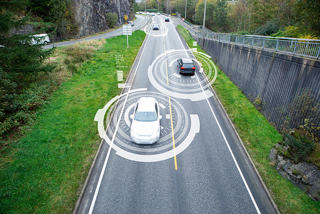More than 3,000 council-maintained road bridges in Great Britain are substandard, new research from the RAC Foundation suggests.
Analysis of data received from 199 of the 207 local highway authorities in England, Scotland and Wales found that 3,203 structures over 1.5m in span are not fit to carry the heaviest vehicles now seen on our roads, including lorries of up to 44 tonnes.
Many of these bridges have weight restrictions. Others will be under programmes of increased monitoring or even managed decline.
The 3,203 bridges represent 4.4% (about 1 in 23) of the roughly 72,000 bridges to be found on the local road network.
The number of substandard bridges is 35% greater than that estimated by the RAC Foundation to have been substandard two years earlier.
The ten councils in Britain with the highest number of substandard bridges are:
|
Local Authority |
Number of bridges |
Number of substandard bridges |
Proportion of substandard bridges |
|
Devon |
2,689 |
249 |
9% |
|
Somerset |
1,459 |
210 |
14% |
|
Essex |
1,567 |
160 |
10% |
|
Northumberland |
964 |
148 |
15% |
|
Cornwall |
1,008 |
127 |
13% |
|
Suffolk |
923 |
121 |
13% |
|
Lancashire |
1,476 |
93 |
6% |
|
Cumbria |
1,911 |
71 |
4% |
|
Gloucestershire |
961 |
69 |
7% |
|
Cambridgeshire |
878 |
64 |
7% |
The ten councils in Britain with the highest proportion of substandard bridges are:
|
Local Authority |
Number of bridges |
Number of substandard bridges |
Proportion of substandard bridges |
|
Slough |
36 |
17 |
47% |
|
Bristol |
140 |
52 |
37% |
|
Croydon |
11 |
4 |
36% |
|
Islington |
6 |
2 |
33% |
|
Middlesbrough |
63 |
18 |
29% |
|
Hammersmith and Fulham |
4 |
1 |
25% |
|
Kensington and Chelsea |
4 |
1 |
25% |
|
Blackpool |
21 |
5 |
24% |
|
Conwy |
234 |
51 |
22% |
|
Bracknell Forest |
123 |
21 |
17% |
A full list of councils is available below together with top ten tables for England, Scotland and Wales.
If money was no object, then councils would ideally want to bring 2,110 of these back up to standard. However, budget restrictions mean councils only anticipate 416 of these will have the necessary work carried out on them within the next five years.
The one-off cost of bringing all the substandard bridges back up to perfect condition would be around £890 million. This is the equivalent of £278,000 per structure.
The total cost of clearing the backlog of work on all bridges – including those that are substandard – is estimated at £3.9 billion.
Councils are currently spending just an eighth of that - an estimated £447 million - per year maintaining their entire bridge stock.
When the local authorities were asked what the biggest challenges they expected to face in the next 10 years in maintaining their bridges; “funding” and “skill shortages” were commonly cited.
The survey of local highways authorities was carried out with the help of the National Bridges Group of ADEPT (the Association of Directors of Environment, Economics, Planning and Transportation).
The RAC Foundation also received data from the bodies responsible for looking after Britain’s strategic roads (motorways and some major A roads):
|
Authority |
Number of bridges |
Number of substandard bridges |
Proportion of sub-standard bridges |
|
Highways England |
12,184 |
166 |
1% |
|
Transport Scotland |
2,440 |
33 |
1% |
|
Welsh Assembly |
1,263 |
48 |
4% |
Steve Gooding, director of the RAC Foundation, said: “It’s the pothole backlog that normally hits the headlines but it is easy to forget all the other aspects of road maintenance that councils are involved in; from clearing ditches to cutting verges to maintaining bridges.
“In the face of growing traffic volumes and ageing infrastructure the danger is that without an adequate long-term funding settlement we will see more rather than fewer bridges with weight restrictions, with the backlog bill getting bigger all the time.”
Liz Kirkham, chairman of the ADEPT Bridges Group, said: “The ADEPT Bridges group supports Local Authority Bridge Managers throughout the country and was pleased to work with the RAC Foundation on an important issue that can get overlooked.
“The figures identified by the RAC Foundation survey present a true picture of the funding backlog our members face.
"The problem is only compounded by the skills shortage in STEM (Science, Technology, Engineering and Maths), which is having a serious impact across all engineering and manufacturing sectors.
“A growing number of substandard and restricted bridges that are not adequately maintained affect journey times and for rural communities in particular have an economic impact, creating barriers to growth."



















Login to comment
Comments
No comments have been made yet.